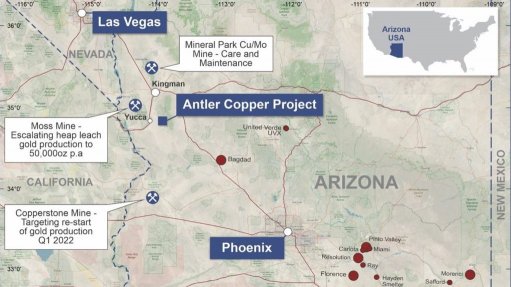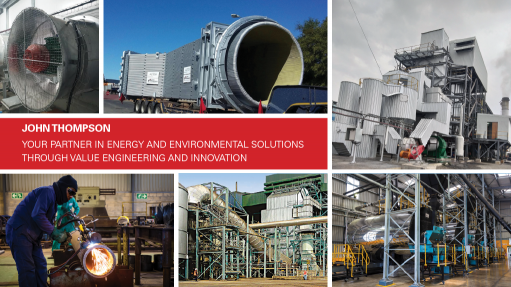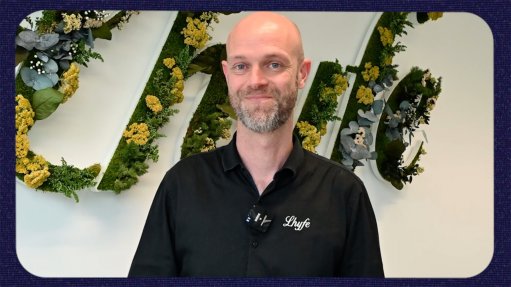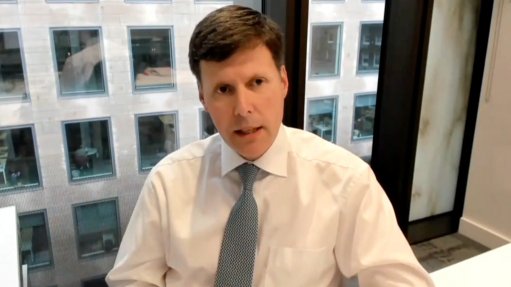Sam Molefi clinches promising contract for his impressive mining business

Modi Mining MD Sam Molefi interviewed by Mining Weekly’s Martin Creamer. Video: Darlene Creamer.
JOHANNESBURG (miningweekly.com) – Modi Mining is a 100% black South African-owned company founded and owned by mining engineer and entrepreneur Samuel Molefi and entrepreneur Christina Motlapele Molefi.
The company was established with the sole objective of rendering differentiated contract mining services and to be a supplier of choice to the mining industry. (Also watch attached Creamer Media video.)
Modi Mining started operations in 2011 and has gone from strength to strength, serving some of the biggest names in the mining business.
Sam Molefi has 25 years of mining experience. He started with Gold Fields Academy and qualified as a mine engineer at Wits Technikon.
Holding a mine manager’s certificate of competency, he has managed local and international projects, including an explosives manufacturing plant in Mali.
Molefi provided technical support to Randgold Resources’ mines in Mali, has done long-term planning with platinum mines and has worked as a mine manager for chrome and ferrochrome mining companies.
In the North West, Modi Mining services some of the biggest of the big mining houses; in Mpumalanga it services the coal sector – and the company also manufactures and supplies products for major Gauteng-based gold mines and the North West-based platinum mines.
Sam Molefi’s latest deal is highly significant in that the contract won is close to his place of birth – Dobsonville, Soweto – and even closer to where his late father worked – Crown Mines, west of Johannesburg.
Modi Mining is now the key contract miner to West Wits Mining, the Australia-listed Witwatersrand gold reviver that is advancing fast on an initial A$9.5-million capital raise.
Helping West Wits Mining to come out of its starting blocks at high speed is an unexpected gold find that will result in revenue being generated considerably sooner than expected.
From next month, West Wits Mining, headed by MD Jac van Heerden, will begin turning valuable vamping material to account that nobody knew was there.
The vamping material escaped the attention of the definitive feasibility study (DFS) because entry of the dormant section of Rand Leases that closed a couple of decades ago was still unsafe at the time.
But that all changed in November and December when a ventilation system was installed, the underground made safe and the ready blasted vamping material came into view.
“It was a nice surprise for us,” an upbeat Van Heerden told Mining Weekly in the same Zoom interview in which he enthusiastically announced the appointment of Modi Mining as the company’s mining contractor.
When West Wits Mining ultimately meets its targeted 50 000 t/m, it will be looking to employ 600 to 700 people.
“At the moment, we’ll employ people through Modi Mining. They’ve got all their systems set up. We try to keep our head office, if I can call it that, relatively small, with most of the focus from the five guys we’ve got here going into Modi Mining, so that Modi Mining can do the employing. Modi Mining has got all the systems set up from their previous contracts. It's a lot easier to employ these operators through Modi Mining,” said Van Heerden.
These are the questions Mining Weekly put to Sam Molefi:
Mining Weekly: What has Modi Mining been contracted to do for West Wits Mining?
Molefi: The scope of our work is quite clear and detailed. It requires us to do the box cut brow support and to rehabilitate the old workings that have been left unattended to for years. So, we are going to be rehabilitating the brow area of the decline and putting in installations to ensure that when we enter the decline, a safe environment can be accessed. We have to make sure that the mine is set up to be able to be operated for a long-term basis. We are on early-stage works where we are establishing the footprint that will allow long-term mining to happen. That includes debushing all around the decline area. As you will recall, these mines were left a long time ago without any work happening there, so there were a lot of trees and bushes and there were no services. We have brought the services back, establishing a footprint to make sure there are services, water and power reticulation, and also infrastructure established and the site fenced off to make sure it's a safe environment to work in.
How many companies did Modi Mining have to compete against to secure this contract?
In terms of the number, I’m not quite sure there, but I know there were other interested parties. We all submitted our proposals and because what we put forward was compelling and competitive, it allowed us to keep on going from the initial phase to the following phases up until we were selected as a preferred supplier.
What was key to Modi Mining being awarded this contract?
What I also want to emphasise is that we submitted the cost estimate, which West Wits Mining uploaded into their DFS process, and I’m led to believe that our base estimates were put in for the NPV and that’s why they decided to go with a profitable approach. However, over and above that was also our experience in the mining industry. We have been in operation as a company for the past ten years, in the contract mining space, underground and on surface, and myself as the MD of the company. I’ve have 25 years’ experience in mining, and being a 100% black-owned company – all that, I think, worked in our favour. Also concerning that, I was actually born in Dobsonville, so I’m a local person. I used to ride a taxi from Dobsonville to Wits Tech back then - now the University of Johannesburg. I never thought back then that mining could be resuscitated in my area. I was led to be part of the process because for me job opportunities being created for the local people is my passion and I’ll be answering to that as well.
What work has Modi Mining already completed for West Wits?
We’ve been there for a couple of months now. The battle has been taken on. We have completed bush clearing. There is a site. You can at least see a mine whereas before it was just bushes and you would never have thought there was a mine there. We have installed surface infrastructure. There is now the perimeter fence and offices. Diesel refuelling bays have been constructed. Power reticulation has been completed. Water reticulation is on progress. We’ve done the brow support for the declines. You know that the brow above the decline is very unsafe unless properly supported. The grouting is also done and we’ve installed the steel arch sets in the decline, and we’re currently doing void filling and grouting the portal area. We have done winze rehabilitation. There’s a decline and a winze in that area that we have rehabilitated and supported. We have also sealed the winze off and installed extraction fans so that we can draw foul air out of the mine, and the fans are currently running as we speak. We’re also busy now supporting the decline to make sure that the pathway to the ore horizon is safe. Those are the key milestones that we’ve achieved and a lot of work has been done to achieve that.
What is the biggest task that still confronts Modi Mining on this contract?
For us, one of the biggest things we have done is to make sure that we have safe access to all the underground workings. The biggest task will be to develop to the reef horizon but we only need to start doing that after we have rehabilitated the whole decline and it is safe. Once we have done that, we need to start blasting the development end on a decline so that we can access the reef horizon. For us the key milestones, the winner here, is to hole into the reef horizon or into those old workings because there is some old vamping material that has been left behind that we are going to be mining ahead of going into the long-term phase of the project. Development and holing into the reef horizon are the key milestones that we need to achieve and they will mark the success of the early stage works of this project.
How many Modi Mining personnel are on site and what is the employment potential going forward?
Currently, because we are still at the early stage phase, we’ve just had to bring in the highly specialised and skilled individuals because the activities that are taking place need experience and expertise. So, we’ve got about a 71-strong team on site. The potential that the project carries in the long-term phase and in steady-state performance, will be close to 700 people with job opportunities for the locals at this mine.
Mining Weekly notes that Modi Mining also serves some of South Africa’s biggest mining houses. How many sites are you on and how many people have you deployed on these sites?
We are on five different sites in different provinces. As a company we employ about 700 people on a permanent basis. The sites are spread across the country owned by different mining houses. We’ve got some big players that we serve such as Implats, RBPlats, Sibanye and there are some other smaller players as well.
What is the size and value of your equipment fleet offering and what do you see as your main strengths, weaknesses, opportunities and threats?
Project wise, at West Wits, we have R8-million worth of equipment on site (excluding the rented equipment). We make sure that we deliver on schedule safely. As a company we have equipment assets to the value of about R119-million. That is the value of our equipment deployed across the country. We draw our strength from our experience in the mining space. I think 10 years has taught us a lot in mining. There have been gains and losses in our journey and all that has resulted in experience to us as a company. Whether we lose or we win, that comes with learning. That is our strength now, because we understand a lot of our clients, a lot of orebodies and a lot of market movement and conditions. We are able now to make a proper analysis of every client that we approach, whether it’s market sentiment, whether it’s the commodity prices in a particular client’s framework. Weaknesses – yes, we are still a growing company so we’re still building and empowering ourselves in terms of systems. There are a lot of systems out there. Some of them are very expensive and we have to have them. We’re still building up in that space and we believe that weakness will reduce in size and impact with time as we keep on empowering ourselves in terms of systems that are used in the mining space. I must say that we’re on a journey of digitisation so we see ourselves removing or reducing that weakness within this year because we have teamed up with Microsoft as part of their digital transformation program in terms of digitisation. Opportunities – we appeal to cost-sensitive clients. We’ve got a lean structure and we are also a low-cost producer. Those clients that target to produce their product lines at lower cost. We tend to appeal to them because we can offer them a tailor-made package that is also cost-sensitive. That tends to bring us opportunities. We get calls because of that. In terms of threats, we have got existing competitors that are strong, established, those that have hundreds of years in mining and have bigger teams and systems. But we use all of these to package ourselves to appeal to our potential clients and even existing clients.
How did Modi Mining come about, who owns it and what are its business aspirations?
Modi Mining is owned by myself and my partner Ms Motlapele Molefi. The company was incorporated in 2007 and started trading in 2011. Going forward our biggest aspiration is to really grow into a space of the so-called Tier 1 companies - companies that are quite big and even listed. It is our dream to go into that space and eventually become a listed entity so that we can be able to access those capital funding structures available in the JSE space. Our aspirations include incurring ownership of resources. We really look forward to achieving those milestones as a company, listed and ownership, so that we can become one of the biggest players in the industry in the future. Our growth does not only benefit us. It also benefits our clients. A typical example is West Wits, where we had to mobilise equipment that is readily available to execute the works. Our growth in terms of assets and experience also benefits our clients because we are able to deliver the projects successfully and also be able to create jobs. The biggest desire and dream of our company is to create sustainable jobs and this will also contribute to our country because we know that our country has got the biggest challenge of unemployment and it will take SMMEs, midtier companies and Tier 1 companies to help the government to eradicate that unemployment. We want to grow so that we can create jobs. Our current employees enjoy sustainable jobs. They have benefit schemes that are good and strong for their wellbeing. So, the more people we employ, the more people will have access to medical aids and retirement schemes and provident funds. Those things are available in our company and we share to make sure that our employees have sustainable livelihoods.
How do you feel about now working on a gold mine revival project so close to your place of birth?
I was born in Dobsonville. My parents stayed there. In actual fact, my father worked for Crown Mines, next to FNB Stadium. He used to tell me about his work there and his past experiences, which could have contributed towards my choice of career. The long and short is that I was there in the early 80s and later moved to the former homeland state of Bophuthatswana, where I did my school learning, and then eventually I came back for tertiary to Dobsonville, because it is our home. Then I got involved with Wits Tech. I got a sponsor from Gold Fields. Actually I was employed by Gold Fields in the early days. First I stayed at home and later on at res. I went back to Gold Fields. As a career, there’s always change, and I went to Sasol, Anglo Platinum and later on I went as far as Mali, West Africa, where I worked in mining. Then I came back home to go into business . That’s when I started doing the proposals to the mines to provide the best suited mining solutions. Our current clients are quite happy with the product and services we provide to them because they come out of a knowledge base and an understanding of mining, There are imperatives in the mining space and we looked out for opportunities and this one here we spotted in a local publication and we raised our hand and ended up being the selected bidder.
Mining Weekly understands you are also involved in exploration. Tell us about that?
Late last year, as a company, we started an exploration programme in the Mpumalanga region and we are now expanding to the North West because we want to really unearth what is out there and create jobs as well.
QALA SHALLOWS AND QALA DEEPS
Following the granting of the mining right and completion of the Qala Shallows Stage 1 DFS in the third quarter of 2021, West Wits has rapidly advanced site establishment, mine development and the early mining initiative at its Witwatersrand Basin Project that highlights the huge potential of South Africa to begin turning its rich legacy resources to positive account.
The rights issue to fund the project was fully underwritten by Evolution Capital.
The company has also completed a share placement on an unrelated investor to raise a further A$1.6-million and has appointed South Africa-rooted Taurum International to raise debt.
The compliant resource estimate of the company’s Witwatersrand Basin Project has hit the 4.28-million ounces mark at a grade of 4.58 g/t of gold.
“That’s quite an exciting grade for us,” said Van Heerden, who described the orebody as strong and the growth potential as considerable.
The Qala Shallows area is where the DFS was finalised last year. There the grades are still at the 3.5 g/t or thereabouts. That is also the 500 m area where mining will start first and where the DFS declared a reserve of about 288 000 oz, a number that is poised to remain until further feasibility studies are completed this year.
With the mining of the vamping material and old available faces due to begin next month, rock engineering and ventilation teams are going all out to identify rock conditions and ventilation requirements to ensure that the reviving operation is in a position to start taking up ore from February/March onwards.
“We estimate that, at least for the next six months, we’ll be in a position to take out about 5 000 t to 8 000 t a month and as we understand the available faces a bit better, we’ll then extend that plan going forward.
“Our DFS project, as we call it, was only really scheduled to click in from about September this year, so what we’ve managed to do with what we call the early mining initiative is to bring quite a bit of activity forward.
“We’re in a position to prove to people that the gold is there and we’re funded for this year to start this early mining. We’re still working on our debt funding initiatives as well and at least for the next six months or so we’re funded to start our early mining initiative,” Van Heerden enthused.
Qala Shallows has got a life of about 14 years and during that time development will go down to Qala Deeps.
Comments
Press Office
Announcements
What's On
Subscribe to improve your user experience...
Option 1 (equivalent of R125 a month):
Receive a weekly copy of Creamer Media's Engineering News & Mining Weekly magazine
(print copy for those in South Africa and e-magazine for those outside of South Africa)
Receive daily email newsletters
Access to full search results
Access archive of magazine back copies
Access to Projects in Progress
Access to ONE Research Report of your choice in PDF format
Option 2 (equivalent of R375 a month):
All benefits from Option 1
PLUS
Access to Creamer Media's Research Channel Africa for ALL Research Reports, in PDF format, on various industrial and mining sectors
including Electricity; Water; Energy Transition; Hydrogen; Roads, Rail and Ports; Coal; Gold; Platinum; Battery Metals; etc.
Already a subscriber?
Forgotten your password?
Receive weekly copy of Creamer Media's Engineering News & Mining Weekly magazine (print copy for those in South Africa and e-magazine for those outside of South Africa)
➕
Recieve daily email newsletters
➕
Access to full search results
➕
Access archive of magazine back copies
➕
Access to Projects in Progress
➕
Access to ONE Research Report of your choice in PDF format
RESEARCH CHANNEL AFRICA
R4500 (equivalent of R375 a month)
SUBSCRIBEAll benefits from Option 1
➕
Access to Creamer Media's Research Channel Africa for ALL Research Reports on various industrial and mining sectors, in PDF format, including on:
Electricity
➕
Water
➕
Energy Transition
➕
Hydrogen
➕
Roads, Rail and Ports
➕
Coal
➕
Gold
➕
Platinum
➕
Battery Metals
➕
etc.
Receive all benefits from Option 1 or Option 2 delivered to numerous people at your company
➕
Multiple User names and Passwords for simultaneous log-ins
➕
Intranet integration access to all in your organisation


















